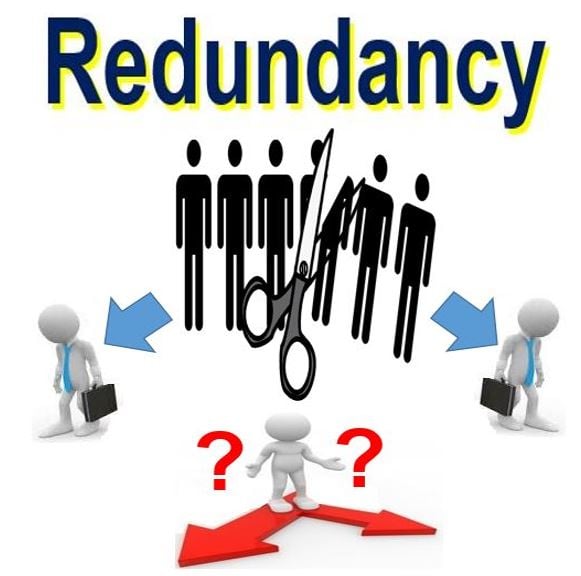How to Handle Redundancy Pay If Company Goes Bust: Key Details for UK Employees
How to Handle Redundancy Pay If Company Goes Bust: Key Details for UK Employees
Blog Article
Examining the Interaction Between Firm Redundancy and Organizational Adaptability for Future Development
In the dynamic landscape of today's service globe, the detailed partnership in between company redundancy and organizational versatility arises as an essential element for continual development and success. Firms often deal with the difficulty of striking a fragile equilibrium in between keeping a degree of redundancy to mitigate risks and fostering versatility to react quickly to the ever-evolving market needs.
Relevance of Firm Redundancy
Firm redundancy is a crucial element that improves organizational resilience and alleviates functional dangers. By including redundancy procedures within the business structure, business can better stand up to unanticipated disturbances and changes in the service atmosphere. Redundancy offers as a calculated buffer, allowing companies to adjust and react properly to unanticipated obstacles without jeopardizing vital procedures.
One trick element of the value of business redundancy is its role in ensuring connection during times of crisis. When confronted with abrupt modifications or emergencies, repetitive systems, sources, or workers can step in to keep vital functions and avoid prevalent interruptions. This continuity not only safeguards the firm's online reputation and client trust yet likewise minimizes economic losses and operational downtime.

Methods for Business Flexibility

An additional crucial technique is spending in modern technology and infrastructure that can support versatility and scalability. Applying digital tools, automation, and data analytics can improve operations, enhance effectiveness, and supply beneficial understandings for educated decision-making. Moreover, creating adaptable organizational structures that allow for quick adjustments to market dynamics and customer needs is essential for staying competitive in a rapidly evolving environment. By proactively recognizing possible disturbances and possibilities, companies can proactively flourish and adapt in an ever-changing company landscape.
Harmonizing Redundancy and Versatility
Accomplishing an unified equilibrium in between functional redundancy and organizational versatility is paramount in navigating the intricacies of a vibrant company atmosphere. Striking the right balance in between redundancy and flexibility is a delicate process that needs a deep understanding of the company's objectives, industry dynamics, and danger resistance.
To attain this equilibrium, firms require to perform normal assessments of their operations to identify areas where redundancy is necessary for risk mitigation and where adaptability can drive innovation and growth. Implementing flexible structures, fostering a society of continual understanding and renovation, and urging open interaction throughout all levels of the organization are key strategies to integrate redundancy and adaptability efficiently. By straightening these two crucial aspects, business can place themselves for lasting growth and success in an ever-changing business landscape.
Case Research Studies on Adaptation Success
In taking a look at circumstances of successful business adjustment, it ends up being apparent that the interaction in between operational redundancy and versatility is a specifying element in shaping resilient organizations. One engaging study is that of Netflix. Initially a DVD rental find solution, Netflix demonstrated impressive adaptability by transitioning into a streaming system when digitalization disrupted the sector. By purposefully buying modern technology and web content development, Netflix not just flourished yet endured in a rapidly developing market. One more standout example is Amazon. Beginning as an online book shop, Amazon constantly adapted its company design, broadening right into diverse fields such as cloud computer and synthetic knowledge. This adaptability permitted Amazon to remain in advance of competitors and meet changing consumer needs. Last but not least, Adobe offers a significant image of successful adaptation. The company changed from selling software licenses to a subscription-based design, ensuring reoccuring revenue streams and boosted consumer engagement. These case studies underscore the importance of operational redundancy coupled with organizational adaptability in cultivating long-term growth and competitiveness.
Structure Durability for Future Development
Structure resilience for future development calls for a calculated positioning of functional procedures with market dynamics and emerging fads. Firms need to adapt to transforming atmospheres by cultivating a culture of versatility, technology, and continuous renovation. Strength entails not just recuperating from obstacles however additionally proactively getting ready for future difficulties. One essential facet of structure strength is purchasing durable danger monitoring methods to alleviate potential disruptions. This consists of circumstance planning, diversifying supply chains, and creating contingency plans for various backups (who pays redundancy money).
Moreover, fostering strong relationships with stakeholders, such as clients, workers, vendors, and the neighborhood, is essential for weathering unpredictabilities and keeping trust fund and assistance during turbulent times. Efficient interaction and openness play an essential function in building resilience, as they aid line up assumptions and facilitate cooperation in browsing useful source unpredictabilities.
In addition, organizations require to focus on understanding and development efforts to upskill employees and equip them with the required tools to adapt to changing circumstances. By buying their labor force, companies can view it improve their flexibility and agility, eventually reinforcing their durability for lasting future development.
Conclusion

In the dynamic landscape of today's service world, the complex connection between business redundancy and organizational flexibility emerges as a crucial element for sustained development and success. Firms frequently encounter the difficulty of striking a delicate equilibrium in between preserving a degree of redundancy to mitigate threats and promoting adaptability to respond swiftly to the ever-evolving market demands.To achieve this balance, business require to carry out normal assessments of their procedures to determine locations where redundancy is essential for risk mitigation and where flexibility can drive advancement and growth.In final thought, the interplay in between firm redundancy and business flexibility is essential for future growth. Building resilience through a mix of redundancy and adaptability will certainly ensure that business are prepared for the obstacles of the future.
Report this page